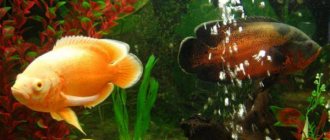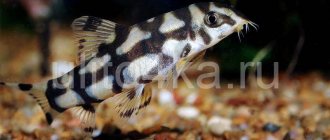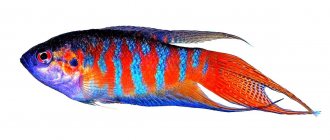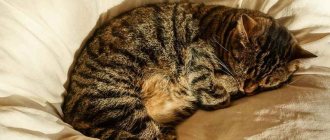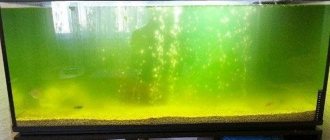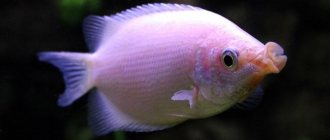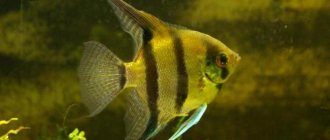An aquarium is a closed ecosystem that lives “in itself.” Any negative process that arises within this system develops like an avalanche, triggering parallel changes leading to a deterioration in the overall situation and the death of the inhabitants.
Since the system is closed, most often only a person, the owner of the aquarium, can stop these processes. Therefore, it is especially important to know the main causes of fish death, to be able to identify them in a timely manner and quickly eliminate them.
Why do fish die in an aquarium?
In the vast majority of cases, the death of fish in an aquarium is caused by errors in the arrangement of an existing aquarium or errors when starting a new aquarium (incorrectly prepared water for the aquarium). Simply put, due to the unfavorable conditions created, the inhabitants experience constant stress, which leads to a deterioration in their immunity and ability to withstand negative environmental influences.
To avoid this, it is necessary to know and understand the basic physical and biochemical processes taking place in aquariums and relate them to the needs of the selected inhabitants. This will help to quickly find the cause of death, eliminate it and prevent further deaths.
Diseases
White-skinned. The culprit of the disease is the microorganism Pseudomonas dermoalba. Newly arriving living creatures and plants introduce bacterial flora into the aquarium.
- Symptoms. The tail and back of the animal are covered with a white coating. A sick fish swims near the surface. The infection has a destructive effect on coordination and the nervous system, which is why pets die.
- What to do. Complete aquarium disinfection, including equipment, soil, plants. Baths with the addition of chloramphenicol help.
Branchiomycosis. The culprits of the pathology are the fungi Branchiomyces demigrans, leading to the appearance of blood clots in the vascular system. The disease is contagious; in 2-3 days the infection kills almost the entire population of the aquarium. Diagnosis in the first stages and immediate therapy are important. Recovery of sick individuals takes up to 10-12 months.
- Symptoms. Animals develop red-brown lines on their gills (a sign of vascular blockage). Sick individuals stop eating and hide in secluded places, pressing their fins to their bodies. As the disease develops, the gill tissues acquire a marbled color and whitish, pink and grayish stripes form on them.
- Actions. Sick fish are removed and treated with solutions of rivanol and copper sulfate. The aquarium and all equipment are disinfected and the water is changed.
Hexamitosis. The culprit of the disease is the ciliate flagellate hexamita (and its varieties). The disease is extremely contagious and is especially dangerous for fish of the cichlid family. The course of treatment is 1.5-2 weeks.
- Symptoms. The body of animals is covered with erosive mucous ulcers. The anus becomes inflamed, the stool becomes thread-like, mucous and white.
- What to do. Antibiotic medications are used (griseofulvin, metronidazole, erythorymycin). The drugs are dissolved in water. Fish food is also soaked in antibiotics. The introduction of varied, nutritious food into the diet and the creation of favorable living conditions helps pets recover.
Gyrodactylosis. The culprit of the disease is the parasitic fluke Gyrodactylus. The parasite attacks the gills, fin and skin of fish.
- Signs. An infected individual floats on the surface of the water, pressing its fins to its abdomen. As the disease develops, the animal loses its appetite and actively rubs against hard surfaces. Grayish-brown areas appear on the body and gills - this is the beginning of tissue destruction.
- Actions. Adding azipyrine and bicillin to the aquatic environment helps. Sick animals are removed and treated with copper sulfate, sodium chloride solution, malachite green and formaldehyde. The water temperature is increased for complete parasitic destruction.
Glucoseosis. The disease is caused by a fungus of the Microsporidia family. It affects the ocular system, gill slits and internal organs.
- How does the disease manifest? The sick individual floats on its side, the body is covered with bloody edema. When the eyes are affected, bulging eyes are observed.
- What to do. This disease is incurable. It is recommended to destroy the aquarium habitats, plants and complete disinfection of all equipment (soil, decorations and containers).
Fin rot. The disease is caused by Pseudomonas bacillus. Often develops in fish that have been exposed to hypothermia. Pets with a veiled, elongated structure of the caudal fins are especially vulnerable to the cold. At the first stage, it is very difficult to detect the disease.
- Signs. The edges of the fins of a sick fish become cloudy, acquiring a bluish tint. As the disease develops, parts of the fin rot (in young individuals the tail disappears). In adults, muscle and skin tissues and blood vessels are affected, resulting in the death of the animal.
- Actions. For therapy, she uses bactericidal agents (baths for sick fish with a solution of malachite green, bicillin or anti-steam). If the maintenance is improved during the initial stages of the disease, self-healing of the animals is possible.
Dactylogyrosis. The development of the disease is provoked by the fluke parasite Dactylogyrus, which attacks fish gills.
- Symptoms. A sick animal loses its appetite, swims near the surface of the water and rubs against hard surfaces, actively making respiratory movements. In a sick fish, the gills acquire a different color (they turn white or variegated). The gill fins stick together, mucus oozes from them, and erosions are observed along the edges.
- What to do. To kill the fluke, the temperature of the aquarium water increases. A solution of bicillin, formalin or table salt is added to it.
Saprolegnia (or ringworm). The culprit of the disease is a mold fungus that affects the skin, gills and body organs. Often this disease develops as a secondary infectious syndrome in an already sick fish.
- Signs. The disease begins with the appearance of thin whitish threads on the skin and gills. As the disease develops, it affects internal organs and leads to the death of the pet.
- Actions. It is necessary to identify and cure the initial ailment, which is accompanied by an infection. If there is no underlying disease, adjusting the conditions of keeping the pet and boosting immunity by bathing in healing baths (with the addition of potassium permanganate, table salt, bicillin, malachite green) will help cure the pet.
Ichthyosporidiosis. Fungal infection caused by the microorganism Ichthyosporidium-hoferi. It has a destructive effect on all organs of the animal, without affecting cartilage and bones.
- Symptoms. A sick individual exhibits spasmodic movements, loss of appetite, and scratching on hard surfaces. The fish constantly lay on their sides and lie on the bottom. Eyesores often develop, and erosive changes in the fins and skin appear. If the internal organs are damaged, the animal dies.
- What to do. There is no treatment. The inhabitants of the aquarium will have to be destroyed, and all equipment must be thoroughly disinfected.
Ichthyophthiriasis (or semolina). This disease is also called “spot disease”. The causative agent is the ciliate Ichthyophthirius multifiliis. The disease has a destructive effect on the gill slits and skin.
- How to recognize. The sick individual actively itches against the hard surface, intensively swallows air, trying to stay on the surface of the water. White dots form on her body. As the disease develops, the fish dies.
- Actions. Bactericides (bicillin, anti-steam, iodine solution of malachite green, bactopur) should be introduced into the aquatic environment every day. The drugs are administered with simultaneous replacement of water by ¼ and gradual heating of its temperature by 5-6⁰ C.
Lepidorthosis. Pathology is caused by bacteria of the Pseudomonas fluorescens and Aeromonas punctata families. The disease is very contagious and has a detrimental effect on the skin of fish.
- Signs. In animals, pustules (bubbles filled with liquid) appear under the scales. Because of this, the fish scales become puffy, and soon they begin to flake off and fall off, leading to death.
- What to do. Cure is possible at the first signs of the disease, when the scales rise in certain areas of the body. The fish will benefit from medicinal antibiotic baths (streptocide, biomycin, bicillin). Medicines are introduced into the aquarium water.
We suggest you read: Cricket, why do crickets sing?
Trichodinosis. The disease is caused by a single-celled microorganism called Trichodina. The disease poses a threat to all common types of fish; the disease destroys the skin.
- Symptoms. It is almost impossible to determine the onset of the disease; the only alarming symptom is when the fish tries to scratch itself on a hard surface. As the disease develops, the animal's color changes (fades), the pet stops eating, grayish areas appear on the body, followed by exfoliation.
- Actions. Increasing the temperature and adding solutions of trypaflavin, table salt, and methylene blue to the aquarium environment helps to destroy the parasite. Sick fish are treated in baths at a water temperature of 33-34⁰ C with the addition of an ammonia solution or table salt.
Ulcerative disease. The culprit is the pathogenic microorganism Pseudomonas fluorescens, which destroys the intestines of fish and the skin.
- Signs of illness. Dark spots and dots appear on the body of a sick animal, and over time, ulcers form. Bulging eyes develop, and inflammatory processes begin in the anus. Abdominal bloating is observed - a consequence of inflammatory processes in the intestines.
- What to do. Fish that are sick can be cured only in the initial stages of the pathology. Solutions of bicillin, streptocide, and biomycin are added to the aquarium. Potassium permanganate or hydrochloride is introduced into medicinal baths and transplants. The aquarium and all accessories are disinfected.
Non-communicable diseases
Alkali disease (or Alkalosis). Excessively soft (acidified) water leads to the development of the disease. This is affected by the abundance of aquatic plants and excess lighting. Alkalosis is a dangerous disease that leads to massive death of fish (they die at night).
- Signs. The luster and color of the animals fades, and mucus appears from the gill slits. The fish begins to move chaotically and convulsively around the aquarium, spreading their fins and trying to jump out. As the disease progresses, the eyes become cloudy, leading to blindness.
- Actions. The fish should be transplanted into another container (with a water pH of 7-8.5). In the aquarium, the acidity of the water will return to normal levels. The fish recover very slowly.
Argulez. The cause is the parasitic crustacean carp eater (or fish louse). The parasite is round and large in size – it is visible to the eye.
- Symptoms. The crustacean penetrates the fish, leaving an erosive wound with mucous contents. The animal actively itches the affected area and loses its appetite. The sick individual hangs in one position, swaying from side to side. The crustacean destroys the skin and muscles of the animal and releases toxins that poison the body.
- What to do. The parasite is carefully removed from the sick fish with tweezers (pre-wrap it with a soaked cotton wool). The wound is disinfected with a manganese solution.
Overfeeding aquarium fish
Excessive feeding is one of the very first causes of death of aquarium inhabitants, especially among novice aquarists.
There is a “golden rule” – underfeeding is better than overfeeding!
The fact is that fish do not have satiety receptors and are able to absorb food in practically unlimited quantities, but to maintain their vital functions they need an amount of food in a proportion of only 2% of their own body weight. The fish in the limited space of the aquarium cannot consume excess food, which results in fatty degeneration and the death of the pet.
The second danger of overfeeding is the decomposition of uneaten food in the aquarium. Leftover feed rots and spoils the water, releasing substances that are toxic to fish.
Elimination of overfeeding:
- feed the fish once or twice a day in small portions, which pets can eat within 1 minute without leaving any residue;
- If possible, remove uneaten food in a timely manner.
Fish diseases
Fish suffer from bacterial, parasitic diseases, and fungal infections. As a rule, many diseases have an aggressive course and are characterized by rapid spread. Some diseases are incurable (fish tuberculosis), others can be cured only in the early stages of their development.
Bacteria and parasites can enter the aquarium along with new fish that have not passed quarantine, algae, and decorative items.
Aquarists should know the main fish diseases and their symptoms. The choice of treatment methods depends on the degree and severity of the disease.
Having noticed that the fish is sick, it needs to be placed in a separate tank as quickly as possible. This will avoid mass infection and death of aquarium inhabitants. It is necessary to remove all carriers of infection, infected or suspicious individuals from the aquarium, so as not to expose the rest of the fish to danger.
Sick fish
If you don’t know how to treat your fish, consult a veterinarian or experienced aquarists. There are no universal cures, but if the fish is sick, you need to increase the aeration of the water, raise the temperature of the aquatic environment, and replace part of the water daily. Antibacterial agents are added to the water. In addition, you need to boil the soil, disinfect the decor, rinse the algae well, and clean the filters. It is necessary to keep the fish in the aquarium until the symptoms of the disease completely disappear and the condition returns to normal.
Oxygen in the aquarium
Fish absorb oxygen from the aquatic environment using gills. The concentration of pure oxygen in water is much less than in the air, and therefore a decrease in its amount very quickly affects the well-being of the fish.
Troubleshooting:
- Avoid excessive population density. There is one very conditional, but more or less valid rule - one liter per centimeter of the length of the fish’s body. That is, for ten individuals one centimeter long, approximately a ten-liter aquarium will be required;
- When the population exceeds the norm and at the first signs of oxygen starvation, it is necessary to use aeration of the aquarium. For this purpose, special aquarium compressors are used.
Causes of fish death
The reasons for the death of aquarium fish can be very diverse - pets die due to improper maintenance, mechanical injuries and diseases. It is important to determine why the fish in the aquarium are dying in order to protect the remaining inhabitants of the tank. Therefore, every aquarist should know the factors that provoke the death of phenotypes.
Nitrogen
Nitrogen poisoning is one of the most common causes of death in aquarium inhabitants. The accumulation of nitrogen in the aquatic environment is caused by fish waste and food debris that the owner does not remove in time. Special tests that are sold in stores will help determine the dangerous amount of harmful substances in a liquid. In addition, the smell of rot and cloudy water are considered signs of an unfavorable environment.
If the cause of the death of the fish lies in nitrogen, then the remaining inhabitants are immediately transplanted into another container with clean water. After this, the old tank is cleaned, the water in the aquarium is replaced by ¼, and filtration and aeration are increased. After these actions, and especially after changing the water, the fish will feel better.
Water temperature
The cause of death of aquarium inhabitants, in addition to nitrogenous compounds, may be incorrect temperature conditions. With the wrong number of degrees, the phenotypes become weak, experience apathy and exhaustion, especially in the summer, when the liquid in the reservoir heats up to unacceptable temperatures.
Due to heating, the fish suffocate from a lack of oxygen in the liquid. A compressor and lowering the temperature of the aquatic environment using air conditioning or bottled ice can correct the situation.
Adaptation
When introducing newly arrived individuals into an aquarium with other pets, you should follow the rules, since rapid adaptation can cause the fish to die in the tank:
- Having brought the purchased pet, first the bag of fish is lowered into the aquarium for 15 minutes.
- After this, a little liquid from an artificial reservoir is added inside the bag, and after 20 minutes, more water. Topping up is done three times.
- New fish are released into the tank with the others.
Nutrition
High-quality nutrition is the key to the health and long life of fish, so you should not skimp on food. By purchasing cheap food, or catching live food in forest reservoirs, the aquarist takes a great risk - the fish can be poisoned, or harmful bacteria and algae can get into the aquarium along with the food.
Leftover food after a meal should be removed immediately, as it causes rotting and poisoning of the aquatic environment, causing pets to die.
Wrong neighborhood
When populating an aquarium with different species of fish, the compatibility of phenotypes should be taken into account. When aggressive and large fish are adjacent to small and weak pets, the latter will be attacked and attacked, or even eaten.
Conflicts can also arise between relatives - males of some species fight for females and territories, as a result of which they die from injuries. Bettas and some species of Cichlids are especially pugnacity.
Diseases
Diseases are the most common cause of death of aquarium phenotypes. Diseases and illnesses usually appear with newly arrived pets, so the following rules should be followed:
- New fish are quarantined for 10-14 days.
- You should only purchase phenotypes, plants, soil and decorations from a trusted store.
- Use high-quality food for feeding fish, the owner of which is confident in its safety.
- Clean and clean the tank regularly.
- Control the number of fish in the aquarium.
If an illness is detected in the tank, you should immediately sort healthy fish from sick ones and replace the water, updating ¼ of the volume. Having determined the type of disease, treatment begins, if appropriate.
When you have to part with a pet, be it a dog or silent fish, it is always a loss and grief for the owner. In order not to have to experience premature death of fish, it is important to follow the rules of care and maintenance, based on the requirements of the fish.
Nitrogen in the aquarium
Nitrogen is an essential element for the life of all animals; it is required for most life processes. However, many intermediate products of the so-called nitrogen cycle are extremely toxic and can kill fish within a few hours. In nature, the breakdown products of nitrogen compounds are quickly neutralized in various ways, but in the conditions of a limited aquarium ecosystem this does not happen.
Troubleshooting:
- weekly water changes with freshly settled water, in the amount of thirty percent of the volume of the aquarium;
- monitoring nitrogen compounds using special tests, this is especially important in new aquariums;
- the use of special bacterial cultures or chemicals;
- avoid overfeeding.
Aquarium water temperature
Most fish kept at home come from tropical countries. Most of our country can hardly be called tropical, so maintaining the temperature to which aquatic organisms are accustomed in their homeland is sometimes very difficult, especially in winter. In addition, sudden changes in temperature should be avoided. Prolonged violation of the required temperature regime, just like hypothermia or overheating, leads to disruption of the animal's metabolic processes and its possible death.
Troubleshooting:
- use of special aquarium heaters with a controller;
- select fish for one tank from similar temperature regions.
Water quality
Utility services do not set themselves the task of purifying the water to such an extent that aquarium residents feel comfortable. Their goal is to make it safe for people and their homes. This is where the popularity of bottled water comes from. Tap water contains maximum levels of chlorine. In large cities, there may be a possibility of a change in water from artesian to desalinated water. As a result, water hardness will increase, which will lead to mass death. You can notice this by the changed behavior of the fish - they begin to rush around the entire aquarium in a state of horror.
This situation can be avoided. For this:
- It is not recommended to change more than 1/3 of the water at a time,
- Leave the water in an open container for at least a day;
- If possible, purchase a water filter with three secretions;
- Use chemicals.
Please note that those fish that were already under stress are susceptible to death.
Aggressive neighbors in an aquarium
Some aquarium inhabitants have more “complex personalities” than others. This must be taken into account when selecting the composition of hydrobionts.
What you need to know when choosing aquarium fish:
- Is the fish territorial? Some fish, for example the Cichlids of Lake Malawi, occupy a certain area in the aquarium and strictly monitor the violation of its boundaries by other inhabitants, especially those similar in size and color;
- You should select fish of similar sizes. Rule: if a neighbor fits into the mouth, then it is not a neighbor, but food. Don't expect fish of very different sizes to become friends;
- Avoid predatory fish. They need certain conditions of detention and even among themselves they rarely live peacefully;
- Try to choose fish from different ecological niches. That is, combine catfish that live and feed on the bottom with animals that prefer the upper and middle layers of water. Avoid food competition;
- Some species, such as Sumatran barbs, like to pluck the fins and whiskers of other species, so avoid putting them in the same tank as veil fish;
- When purchasing, be sure to consult with a specialist about the behavioral characteristics of the species you are purchasing.
Incorrect launch of fish
Imagine what a fish experiences when it gets from one water to another, the parameters of which are significantly different. When you buy a fish at a pet store, you deprive it of its usual environment, transferring it to your own, which is completely unfamiliar to the fish. Water differs in hardness, temperature, acidity, etc. Of course, the reaction to such a change will be stress. A sharp change in acidity by even 1 unit means death for sensitive fish. Sometimes the difference in acidity is much greater, so the shock that the fish experiences can be fatal.
Correct adaptation of fish to a new environment:
- Pour the water along with the fish into a large vessel;
- Add some water from the general aquarium;
- After 10-15 minutes, repeat the procedure;
- Dilute the water to at least 70% solution.
Even if several new fish managed to survive after a devastating change in water parameters, they will certainly die with the first illness. The immune system is significantly weakened, which means that bacteria attack them first. Keep a close eye on aeration, cleanliness and new residents. At best, the health of the fish returns to normal.
Spawning period of aquarium fish
In part, this point overlaps with the previous one. During the spawning period, almost any fish, even the most peaceful ones at normal times, are characterized by increased aggression.
There are not many options for solving this problem:
- Do not create conditions for breeding in a community aquarium;
- When signs of spawning behavior appear, place loving pets in a separate aquarium;
- Engage in reproduction in a special spawning tank, where all the necessary conditions have been created.
Fortunately, most fish will not simply spawn in a community aquarium, and therefore you will not have to encounter this problem too often.
Incorrect check-in
How many fish can you keep in an aquarium? The number of inhabitants depends not only on their length and build, but also on their behavior. In small aquariums (20-30 liters), it is better to keep small, thin fish, adhering to the rule: one liter of liquid per centimeter of animal length.
For flocking, aggressive and large pets, containers of one hundred or more liters are suitable. Overpopulation threatens a lack of oxygen and, as a result, the death of animals. An important factor for the full life of fish is the light in the aquarium.
Diseases of aquarium fish
A pet's illness is almost always a consequence of non-compliance with the above rules. And first of all, it is necessary to eliminate the existing problems in the aquarium and isolate sick individuals. However, sometimes you can introduce an infectious disease with new pets, so when introducing new pets, they must first be kept in a separate quarantine aquarium for about two weeks.
Treatment of the identified disease should be carried out with special drugs recommended by a specialist, preferably in a separate container. Most symptoms of aquarium fish diseases are nonspecific, that is, the same signs will occur in different diseases, so consultation with a knowledgeable person before starting treatment is highly advisable.
What to do if the fish in the aquarium die one after another
If you follow all the recommendations and rules set out in this article, the likelihood of death of pets in your home aquarium is minimized.
A set of initial measures in case of regular or mass death of fish:
- Check the temperature;
- Check for external signs of diseases - clouding of mucous membranes, eyes, ruffled scales, rotting, separation of fins, ulcers on the body, spots of any unusual color on the body;
- Identify uncharacteristic behavior - ingestion of oxygen from the surface, any deviation from normal behavior;
- Check the basic chemical parameters of the water using aquarium tests;
- If any problems are identified, take measures to eliminate them;
- If necessary, consult a specialist and carry out the recommended treatment.
It is important to remember that a well-balanced and properly maintained aquarium is a stable and healthy system in which fish feel comfortable, have good immunity and only die from old age.
What to do if you find a dead fish?
1.Take a closer look
Check and count your fish daily at feeding time. Are they all alive? Is everyone healthy? Does everyone have a good appetite? Six neon and three speckled, all in place? If someone is missing, check the corners of the aquarium and lift the lid, maybe it is somewhere up in the plants? But you may not find the fish; it is quite possible that it has died. In this case, stop searching. As a rule, a dead fish still becomes visible; it either floats to the surface or lies on the bottom, the floor is covered with snags, stones, or even ends up in the filter. Inspect the aquarium every day to see if a dead fish has appeared? If found, then...
2.Remove dead fish
3.Inspect the dead fish
4.Test the water
Analyze
catfishes.ru>
